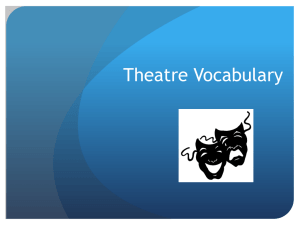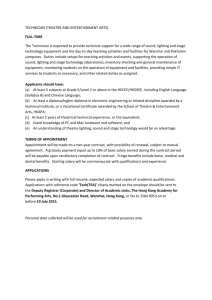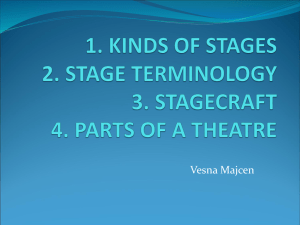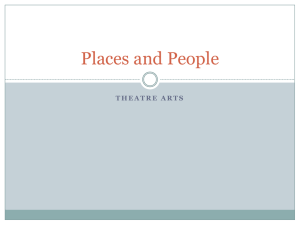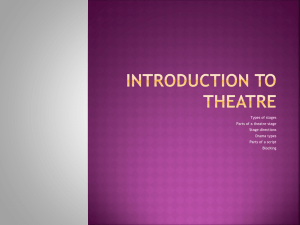Stage Types & Theatre Vocabulary
advertisement
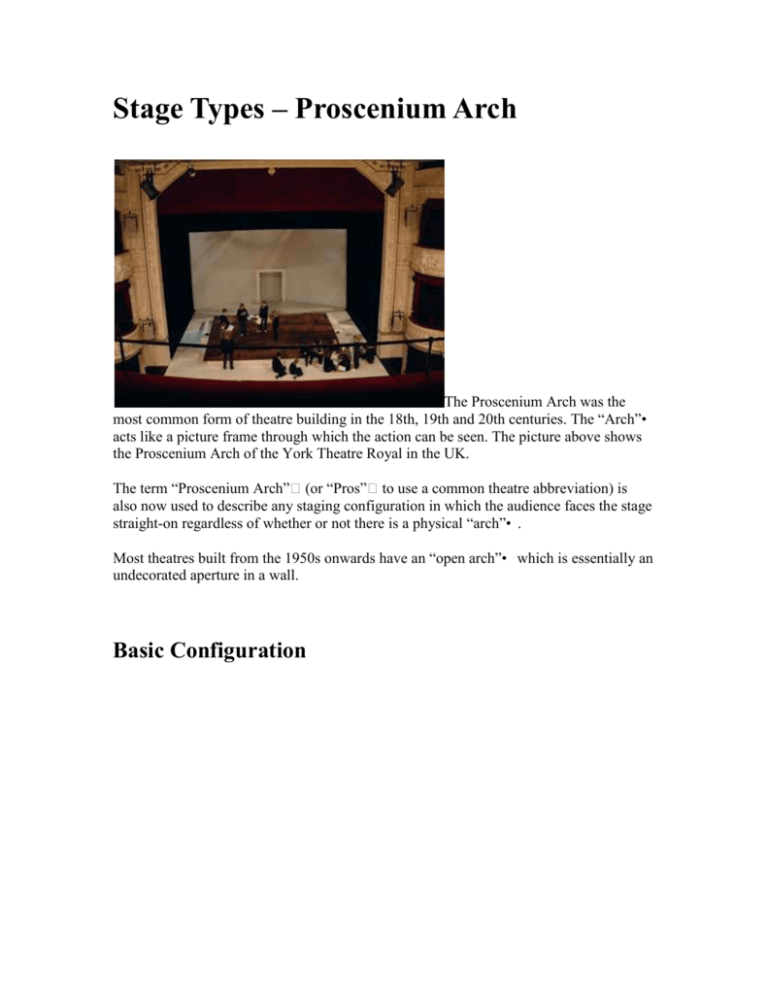
Stage Types – Proscenium Arch The Proscenium Arch was the most common form of theatre building in the 18th, 19th and 20th centuries. The “Arch”• acts like a picture frame through which the action can be seen. The picture above shows the Proscenium Arch of the York Theatre Royal in the UK. The term “Proscenium Arch” (or “Pros” to use a common theatre abbreviation) is also now used to describe any staging configuration in which the audience faces the stage straight-on regardless of whether or not there is a physical “arch”•. Most theatres built from the 1950s onwards have an “open arch”• which is essentially an undecorated aperture in a wall. Basic Configuration This diagram shows the basic configuration for a Proscenium Arch Theatre. The Audience faces the stage. “Wings”• sit by the left and right sides of the stages, used to store scenery, effects and act as waiting areas for actors. Proscenium Arch – With Apron Proscenium with apron An Apron is a segment of the stage which protrudes through and beyond the Proscenium Arch. Traditionally the apron was used by actors to “break through― the proscenium and directly address the audience (in an “aside” for example). The apron was also used by comic performers or Master of Ceremonies in Music Hall or Vaudeville productions. Some debate exists as to how far back in European theatre history the concept of “breaking through”the Proscenium goes. For example we know from the text that Shakespearian characters addressed the audience but it’s believed that all of Shakespeare’s characters were aware of their audience. This contrasts to the renaissance theatre style in which only characters who entered the apron or directly confided in the audience were aware of the auditorium and its audience. Stage Types – Thrust Greek Amphitheatre Hang on… that’s a photo of a Greek Amphitheatre! Yes… it’s the amphitheatre at Hierapolis in Turkey (part of Greece in ancient history) and it’s also a thrust theatre. The Thrust configuration is the oldest known fixed type of staging in the world, and it is thousands of years old! Thrust Stage – Basic Configuration Thrust Theatre Groundplan As you can see the basic shape of a modern thrust is not too different to the ancient Greek. Thrust staging gives a good all-round and closer view of the action, however this better view also comes at a cost – large scenic elements can only be placed at the rear of the stage. Thrust Stage with Proscenium Arch Thrust Stage with Proscenium Arc However there are ways around the sight-line problems a thrust stage offers – in the 1960s and 70s new thrust theatre buildings started to incorporate a shallow proscenium style recess in the back wall. This enabled designers to include scenic effects such as large scale flying and larger structures in designs. This Hybrid Thrust-Proscenium has also been approached from the opposite direction with many traditional Proscenium Arch theatres building Aprons that thrust out into the auditorium. Stage Types – Theatre in the Round Theatre in the Round Theatre in the Round became increasingly popular in the late 1960s in the UK and Europe, with initially the format proving popular in smaller venues and studio spaces. The first “Theatre in the Round”• theatre in the UK was the formed by Stephen Joseph in 1955, now called the Stephen Joseph Theatre. However, a permanent location was not found until 1988 by artistic director and playwright Alan Ayckbourn. The first large Theatre in the Round was built in a disused corn exchange in Manchester in 1976 and was named “The Royal Exchange Theatre”•. The Royal Exchange is now one of the country’s most well known theatre outside of London. The first Theatre in the Round in America was the built at The University of Washington in 1940. Theatre in the Round offers the audience a closer intimacy with the stage than proscenium theatre, and it also puts the audience in direct view of each other. A 360 degree sight line means that large scenery is out of the question unless it is suspended above the actors’ heads and out of the audiences’ view. Theatre in the Round tends to be a format chosen for intimate productions, although some large scale operas and theatre productions have also used the format. Stage Types – Traverse Traverse Stage Traverse is a form of catwalk – though in its purest form it does not have the stage and back wall area that a fashion catwalk has – the purest form of traverse is illustrated above. Traverse offers an intimate setting and has also been used to great effect in larger productions. For example in 1991 The Derby Playhouse Community Theatre mounted a large scale production based on the events on Christmas Day in the trenches of World War 2 in 1914. The German and British armies (composed of a cast of hundreds) faced each other across the stage. Traverse is (not surprisingly) well suited to scenes of confrontation; however its catwalk feeling makes for dynamic fast paced entrances when called for. Technical Theatre Vocabulary A Action – what’s going on onstage. Act Drop – cloth flown in at the end of an act. Apron – section of stage that extends beyond the Pros. Auditorium – where the audience sit! B Backcloth – flown cloth behind scenic element. Backing Flats – flats behind scenic element. Backlight – light that illuminates from behind. Backstage – part of theatre building behind stage. Bar – metal tube used for hanging scenery or lanterns. Barn-door – device to adjust spill of light on a fresnel lantern. Batten – 1) length of wood attached to cloth to keep it taught. 2) group of flood lights. Beginners – call given to cast/crew involved in opening of play. Blocking – recording of movement on stage. Board – abb. for “lighting control board” Book – means script or Prompt Book. Book Flat – a hinged flat. Boom – vertical hanging bar. Border – flown scenic element used in masking. Box Set – Interior set built from flattage. Brace – portable support for flats. Breaking Down – artistic process of aging costume, props or scenery. Bridge – catwalk above auditorium or stage. Build – increase sound or light levels. C Carpenter – (Scenic, Deputy, Master): maker of scenery. Check – decrease sound or light levels. Clamp – normally used to attach lanterns to bars. Cloth – scenic canvas. Control Room – where lighting and sound is controlled from. Counterweights – system used for lowering and raising scenery. Cross-fade – in lighting or sound, change at which some channels are increased while other are lowered. Cue – verbal/physical signal for action or effect to begin. Cue to Cue – rehearsal in which dialogue is reduced to technical cues. Cue Lights – system of lights used to give “Cues”. Cue Sheet – list of effects. D Designer – set/costume/lighting/sound. Diffusion Gel – also called Frost. Softens light. Dimmer – device that controls electricity passed to lanterns. Downstage – area of stage nearest audience. Dress Parade – costume check on stage. Dresser – crew member who aids with dressing. Dressing – to dress set. Dress Rehearsal – Dress full costume/lighting/effects/soundaction rehearsal. E Effect – sound/lighting/scenic. Electrician – (Chief, Deputy, Assistant) responsible for lighting. Elevation – technical drawing showing side view. Elex Tape – or “LX” tape sticky back plastic tape available in various colours. Ellipsoidal – type of reflector used in profile spots. Engineer – usually “sound” but can be “lighting” Entrance/Exit – points in script and physical space where performer comes and goes! F Feedback – when a mic picks up its own signal from a speaker. Flat – unit of scenery. Floods – lanterns with no lens. Flown – scenery or equipment which has been “flown” into the flies. Fly – raising scenery above audience sight level. Flyman – crew member operating flying equipment. Fly Tower – structure above stage containing flying equipment. Focus – adjustment of lighting/projection equipment. Focussing Session – when adjustment and plotting is done. Follow spot – Large profile spotlight with operator. Fresnel – spotlight with fresnel lens that gives soft edge. G Gaffer Tape – sticky back fabric tape. Gain – the “master” volume control on mixer. Gel – coloured lighting film (originally made from gelatine) Gobo – metal slide placed in gate of lantern which throws a pattern. Grave Trap – body length trapdoor in stage. Green Room – cast/crew recreation room. H Halogen – gas contained in lamps. Heads Up – warning shouted if anything is dropped from above. House – the audience. House Manager – often ‘œFront of House Manager’ House Lights – lights illuminating the audience. I In The Round- audience seated on all sides of stage. K Kill – instruction to stop action or effect. L Ladder – framework in shape of ladder. Lamps – the thing that creates light in a lantern (“bulb” in domestic terms) Lantern – stage light. Leg – flown cloth or flat masking side of stage. Level – intensity of sound or light. Lighting Plot – lighting cue description. M Mark It – instruction to record position of performer/object on stage. Mask – to hide from audience’s sight. Masking – flats/cloths used to Mask. Master – lever/slide which controls all sound or light. Model – model of stage design. O Offstage – outside performance area. Out – piece of scenery that has been flown “Out” Overture – music which starts a musical performance. P PA System – the public address system or any sound system. Pan – to move light or sound from one place to another. Pancake – water based stage make up, applied with sponge. Par Can – type of lantern containing a fixed beam par lamp. Personal – small prop, retained by actor. Pit – area at front/beneath stage where musicians sit. Plot – any list of cues. Practical – a working object onstage, such as a door or window. Preset – position of scenery and effects at start of performance and scene. Production Manager – person in charge of all technical aspects of the production process. Production Meeting – meetings for staff involved in production. Prompt Copy/Book – the master copy of the performance, including all blocking, effects and cues. Prompt Corner – place where prompt corner was placed now usually behind the audience. Prop – abb. for Properties. Any items used onstage which are not costume or scenery. Prop Table – table situated in wings on which props are placed. Prop Box/Skip – place to store props. Props Room – Room for construction of props by Stage Managers or Property Master. Pyrotechnics – bombs, bangs, flashes etc. R Rake – incline of the stage. Readthrough – usually the first meeting with full company and director. Record – plotting a lighting cue by saving it to the lighting board. Rigging – fixing lighting, sound and scenic devices to the theatre structure. Run – number of performances in production. Run Through – rehearsal that “runs through”• two or more scenes. S Scatter – low level light cast at side of normal light beam. Scenic Artists – people who paint scenery. Scrim – same as Gauze. Set – prepare stage for action. Setting Line – line past which no scenery, props or furniture may be set. Shutter – device in lantern used to shape beam. Sightlines – angles of visibility from audience. Slots – side lighting position in auditorium walls. Spike – nail something to floor. Spill – unwanted light on the stage. Stage Brace – extending support for scenery. Stage Crew – employed to move/operate scenery. Star Trap – a mechanised trap where actor shoots through stage floor. Strike – to remove object or scenery from stage. Strobe – flashing light. Swag – curtains fashioned so they do not hang straight. T Throw – distance between lantern and object. Thrust Stage – multi-sided stage (with at least one back wall) Traverse – staging with audience facing each other. Treads – steps or stairs. Truck – platform with wheels. W Wardrobe – department where costume is constructed. Wardrobe Maintenance – washing and repair of costume. Working Lights – lights used by stage crew to aid work.
